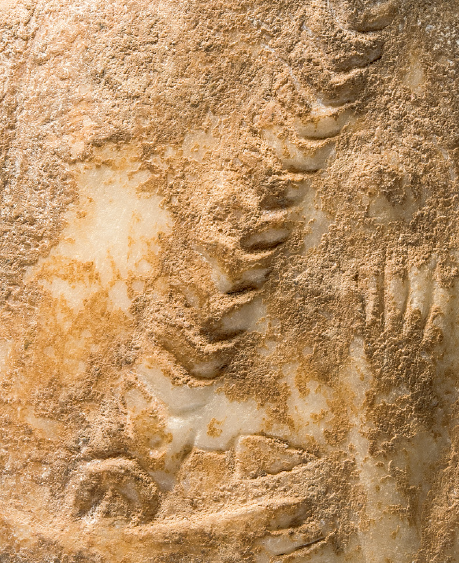The function and meaning of the cycladic figurines
CYCLADIC ART

Unfortunately, the archaeological data is insufficient due to the extensive looting that took place on the Cycladic islands in the 1950s and 1960s, which was the result of the increased value of marble figurines in the international art market during that period. It has been estimated that out of approximately 1400 known figurines, only 40% of them were recovered through systematic excavation.
Even with such incomplete data, however, it is clear that–leaving aside the unique case of Keros–most Cycladic figurines come from graves. This has led many scholars to associate them with funerary rituals, although the theories proposed vary considerably.
A FERTILITY GODDESS?
The numerous female figurines have been interpreted in a variety of ways: as representations of the deceased, or as substitutes for concubines, servants, ancestors, and even human sacrifices. Other scholars have focused on the possibly mystical character of the statuettes and what has been perceived as an overwhelming bias in Cycladic art towards female representations.
In this light, these scholars have attempted to explain them as symbolizing a mother-goddess, figures associated with fertility and rebirth, guides for souls in the afterlife, apotropaic (protective) images, divine nurses, or even worshippers. Some of the scholars that support this view suggest that the primary use of the figurines may have been in shrines rather than graves (although the evidence for specialized cult areas in the Early Bronze Age Cyclades is extremely limited). There are also theories that focus on social dimensions (e.g., representations of females in the age of marriage) or attempt to offer practical, though rather unlikely, explanations (figurines as toys).
Although each of these interpretations is based on sound argumentation and may carry seeds of truth, the general scholarly consensus is that the figures’ nudity, clearly rendered breasts, and defined pubic triangle refer directly to the idea of fertility. In line with this, some scholars believe that the swollen bellies visible on some figurines and the horizontal grooves on others symbolize pregnancy or recent labor.
Fertility, invariably associated with female divinities, was a central theme in the religions of the ancient Mediterranean and Near Eastern people. As such, there is no reason to doubt that this would also be the case for Cycladic islanders, though whether Cycladic female figurines were meant to represent female fertility goddesses cannot be determined with certainty. However, the extreme regularity observed in their appearance (since they were produced in the same standardized form for more than five centuries) supports the hypothesis of a ritual function. The characteristic posture, with the folded arms, recalls comparable groups of religious statuettes from other eastern Mediterranean cultures (Syria, Palestine, Cyprus, etc.) and may have been a widely accepted, symbolic type of divine representation. An alternative interpretation states that they could represent a worshipper in a gesture of reverence. However, this hypothesis fails to account for the nearly complete absence of male statuettes in this characteristic position. Therefore, the fertility goddess theory remains the most plausible explanation.
A RELIGIOUS SYMBOL OR A SYMBOL OF AUTHORITY?
However, this hypothesis does not explain the entire meaning and function of Cycladic figurines. Several questions remain unanswered: What was the precise relationship between fertility to funerary rituals? Why do we only find figurines in some graves and usually (but not always) in the ones with more expensive grave goods?
How do we explain the discovery of figurines in settlements and other non-funerary contexts (e.g., in Keros)? Why were there fewer male figurines and groups of figures? What was the function of the rare large-scale female statues, which were too large for an Early Cycladic grave? What was the role of painted decoration on the face and body of some figurines?
Further research is the only thing that might provide satisfactory answers to these questions, since the available data only allows for some general remarks. On one hand, the obvious standardization and conservatism of Cycladic figurines make it likely that they functioned as major religious symbols.
On the other hand, the diversity we observe in features like size, decoration, and context of use, as well as the very existence of other figurine types, reflect a considerable degree of differentiation in their production, availability, and utilization.
This differentiation may relate both to ritual issues (e.g., the need for figurines of a particular type, size, or decoration for each ritual) and social factors (the availability of marble figurines, their size and decoration as reflecting social properties such as the age, lineage, and the status of the owner).

The more we study Cycladic figurines, the more we come into the understanding that their function was much more sophisticated than people originally thought. Despite the stylistic uniformity, they are found in a variety of contexts in association with different types of objects, though their distribution in cemeteries and settlements is very uneven.
Careful examination of material from systematic excavations may reveal important information about their use and help us to better understand their meaning. Moreover, it will probably demonstrate that they form part of a complex phenomenon of ritual action and social behaviour, which cannot be explained with a single, simplistic model of interpretation.



